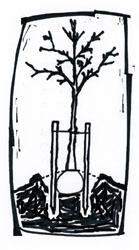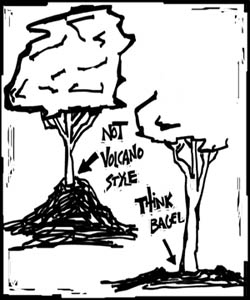Planting Trees and Shrubs
He that plants a tree loves others beside himself – Thomas Fuller
1. Before Planting. Take a moment to consider something that could make a huge difference in the health of your plant. What kind of soil and drainage does the site have? Most failures of new plantings in coastal BC are due to waterlogged soils. If you have heavy, clay soil, one way to avoid problems is by raising the planting area. Planting in a beam or slightly raised mound is an excellent way to get the roots out oaf a wet area. If, when digging the planting hole, you run into clay, it is better to stop digging and instead make that the bottom of your planting hole. Mound soil up around the root ball, starting well away from the plant, to achieve the proper planting height.
![]() 2. The Planting Hole. Dig the hole the depth of the root ball, but at least twice its width. Loosen the soil around the hole with a shovel or spade fork. Most roots spread away from the plant in the top six inches and this is why it is important to dig a shallow, wide hole so that the roots can travel more easily.
2. The Planting Hole. Dig the hole the depth of the root ball, but at least twice its width. Loosen the soil around the hole with a shovel or spade fork. Most roots spread away from the plant in the top six inches and this is why it is important to dig a shallow, wide hole so that the roots can travel more easily.
3. Planting Container Trees and Shrubs. Remove the plant from the container and set the root ball on its side. Handle carefully, especially if the plant is not well rooted. If root-bound, carefully loosen the root ball. If the roots circle the inside of the pot, use a sharp, clean knife to make four vertical cuts, about a half an inch deep, into the lower half of the root ball (about half way down the side and across the bottom). Place the plant in the hole and ensure that it is planted at the proper height. The first major root flare should be just below the surface of the soil. Not deeper (the roots may suffocate).
Planting Balled and Burlapped Trees and Shrubs. Set the root ball into the hole and check to see if the planting height is correct. The first major root flare should end up just below the surface of the finished soil level. Note that the burlap is usually tied around the trunk at a point much higher than the original soil level. Once the root ball is at the proper height, cut the strings and fold the top part of the burlap down the side of the root ball. Do not try to remove the burlap – the root ball can easily fall apart. Be sure to remove all twine or wire from around the trunk and top of the root ball.
4. Backfilling. Once your container or balled and burlapped plant is in place, fill the hole gently, but firmly, making sure that all gaps and air spaces are filled with soil. Good, rich native soil is best, but very poor soils can be amended with compost or rotted manure. Add a few handfuls of bone meal to the backfill soil and mix well; it will help promote new root growth. Do not apply a high nitrogen fertilizer at planting time – it may burn the roots. Wait at least three weeks before fertilizing and do not fertilize if planting after August 15th.
 5. Staking Trees. If the tree is too tall to stand alone, it must be staked to avoid shifting in heavy wind or rain. Use two strong stakes, driven into the ground just outside the root ball. Staking must be done carefully with soft strapping material or wire padded inside old hose. Stake at the lower third of the trunk (a 12 foot tree would be staked at four feet above ground). Do not stake to rigidly – leave enough slack to allow some movement. Remove the stakes when the tree is firmly rooted – no longer than one year after planting. Staking is important. We will not guarantee any of our trees if they have not been staked.
5. Staking Trees. If the tree is too tall to stand alone, it must be staked to avoid shifting in heavy wind or rain. Use two strong stakes, driven into the ground just outside the root ball. Staking must be done carefully with soft strapping material or wire padded inside old hose. Stake at the lower third of the trunk (a 12 foot tree would be staked at four feet above ground). Do not stake to rigidly – leave enough slack to allow some movement. Remove the stakes when the tree is firmly rooted – no longer than one year after planting. Staking is important. We will not guarantee any of our trees if they have not been staked.
6. Watering. Water well, with a slow soaking to the full depth of the root ball. Build up a ring of soil to make a saucer right over the root ball. This allows good, deep irrigation with your hose on trickle, and is especially important for balled and burlapped plants. Water new plantings adequately, especially in the heat of summer. Keep the soil moist but not soaked, as over watering can cause leaves to turn yellow or fall off. When the soil is dry 3-4 inches below the surface, it is time to water.Staking Trees. If the tree is too tall to stand alone, it must be staked to avoid shifting in heavy wind or rain. Use two strong stakes, driven into the ground just outside the root ball. Staking must be done carefully with soft strapping material or wire padded inside old hose. Stake at the lower third of the trunk (a 12 foot tree would be staked at four feet above ground). Do not stake to rigidly – leave enough slack to allow some movement. Remove the stakes when the tree is firmly rooted – no longer than one year after planting. Staking is important. We will not guarantee any of our trees if they have not been staked.
- 7. Mulching. Mulch the area around the plant to at least its drip line. Ground bark (but not cedar), compost, or leaf mold is good choices. A mulch layer 3 or 4 inches thick insulates the roots from heat and cold, suppresses weeds, and reduces the amount of watering required. To avoid crown rot keep the mulch from direct contact with the lower trunk. This part of a plant likes to be high and dry.


